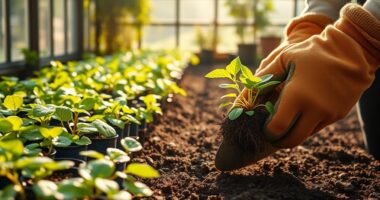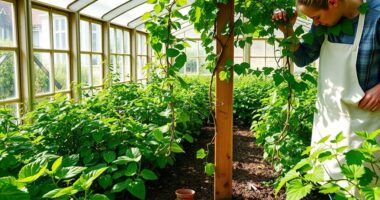Fertilizing plants in a greenhouse is essential to keep them healthy and thriving. You need to select the right type of fertilizer—whether it's organic, slow-release, or a balanced NPK compound. Applying nutrients effectively is important too; methods like top-dressing and fertigation can boost uptake. Monitor your plants for signs of nutrient deficiencies or excesses, and adjust accordingly. With the right knowledge, you can optimize your growth conditions and discover even more strategies for success.
Key Takeaways
- Use compound (NPK) fertilizers tailored to specific crops for balanced nutrient supply and optimal growth.
- Apply organic fertilizers to enrich the soil with essential macro- and micronutrients from natural sources.
- Implement fertigation for efficient nutrient delivery through irrigation, enhancing plant uptake.
- Monitor nutrient levels closely to avoid over-fertilization, which can harm plant health and productivity.
- Adjust fertilizer application methods, like top-dressing or foliar application, based on plant growth stages and needs.
Importance of Fertilization in Greenhouses
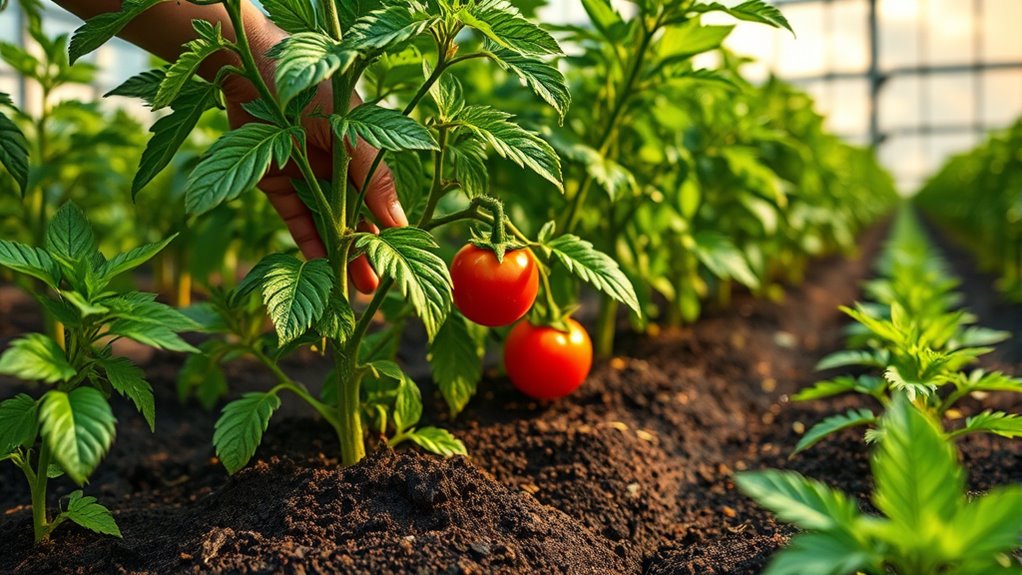
When you cultivate plants in a greenhouse, fertilization becomes essential to prevent nutrient deficiencies that can arise from continuous substrate use. Without proper nutrients, your plants might struggle, leading to reduced productivity and vulnerability to diseases.
Each plant type requires specific fertilizers, so identifying the right one is vital for success. In a controlled environment like a greenhouse, you can precisely manage fertilization to support ideal growth. Balanced nutrition helps avoid deficiencies or toxicities that can harm plant health.
Additionally, adequate fertilization guarantees high-quality crops, boosts vigor, and supports healthy growth stages. By maintaining a consistent nutrient supply, you pave the way for thriving plants and a bountiful harvest.
Types of Fertilizers for Optimal Growth
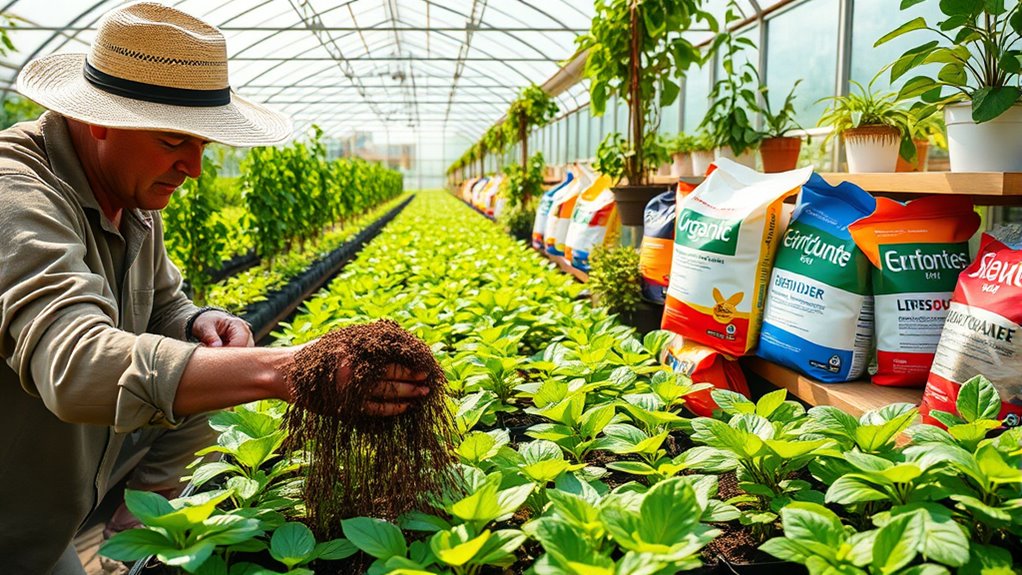
Understanding the types of fertilizers available is essential for achieving ideal growth in your greenhouse plants.
You'll encounter compound (NPK) fertilizers, which provide balanced nutrients tailored for specific crops. Organic fertilizers, derived from natural sources, enrich soil with macro- and micronutrients.
For steady growth, consider slow-release fertilizers that nourish plants over time. Inorganic fertilizers, available in solid or liquid forms, are also popular choices.
Don't forget micronutrient fertilizers, supplying essential trace elements like iron and zinc. You can use liquid fertilizers for precise applications, while granular options offer slow nutrient release.
Soluble powders dissolve easily in water, making application straightforward. Choose the right combination based on your plants' needs, ensuring balanced nutrition for peak growth.
Methods of Fertilizer Application

Choosing the right type of fertilizer is just the start; how you apply it can greatly impact your plants' health and growth.
Selecting the right fertilizer is crucial, but application methods play a vital role in enhancing plant health and growth.
There are several effective methods to evaluate. Top-dressing is easy and flexible, allowing you to adjust per plant, while sub-dressing minimizes weed growth by placing the fertilizer just beneath the surface.
Incorporation mixes fertilizer into the growing medium before planting, which is efficient for large operations. Fertigation delivers nutrients through irrigation, increasing uptake efficiency.
Finally, foliar application sprays nutrients directly onto leaves for quick absorption. Each method has its advantages and challenges, so think about your greenhouse size and specific needs when deciding the best approach for your plants.
Understanding Nutrient Requirements
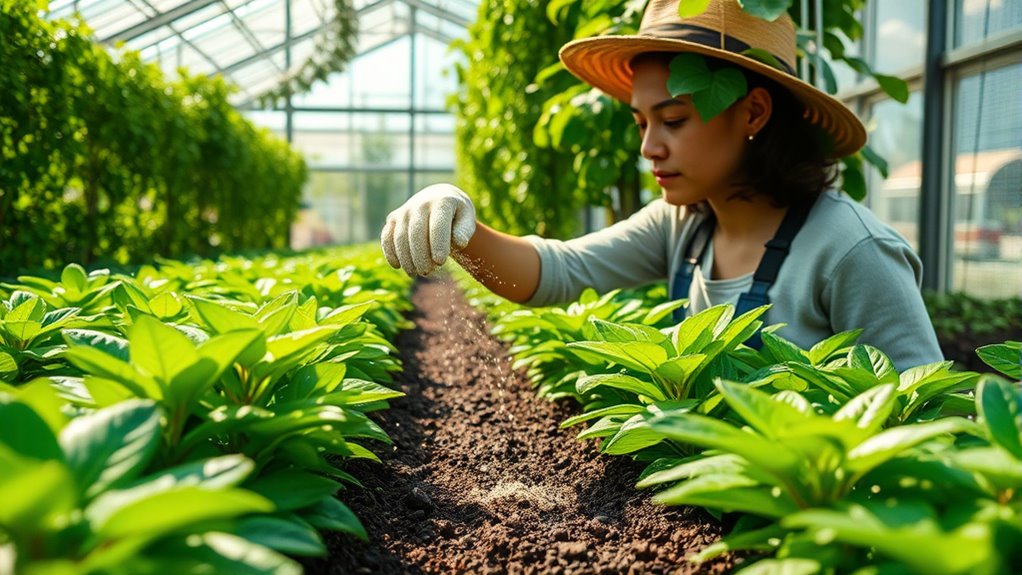
Nutrient requirements for greenhouse plants can vary considerably based on their growth stage and specific needs.
You'll find that macronutrients like nitrogen, phosphorus, and potassium are needed in larger quantities, while micronutrients such as iron and zinc are required in smaller amounts.
During the early growth stage, moderate levels of these nutrients support development.
As plants shift to the fruiting stage, their demand for nitrogen and potassium increases to guarantee healthy fruit formation.
In the mature stage, higher concentrations of nutrients are essential for peak fruit quality.
Adjusting nutrient levels according to these stages not only promotes balanced nutrition but also prevents deficiencies, making sure your plants thrive throughout their growth cycle.
Developing Effective Fertilization Programs
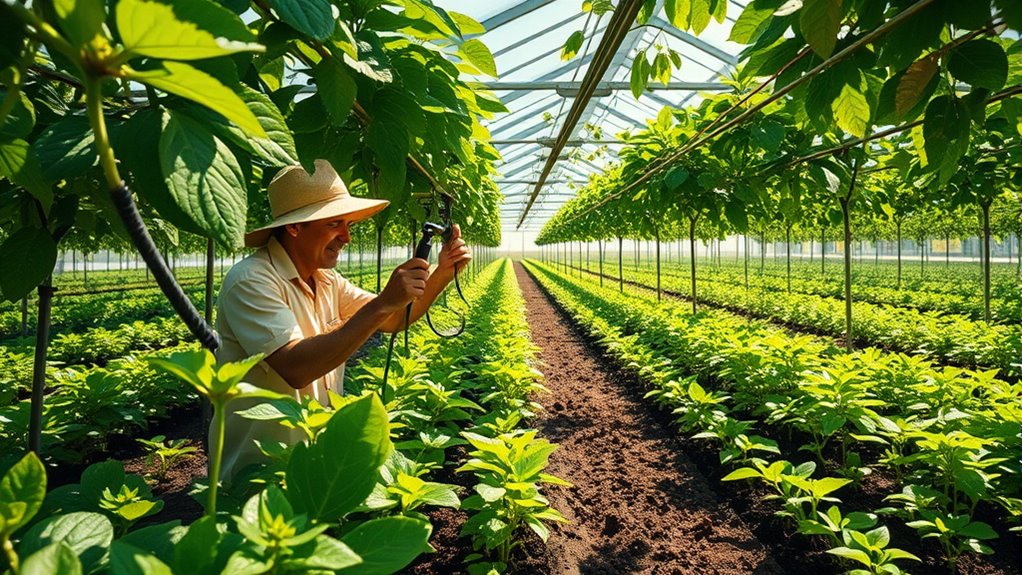
When you develop effective fertilization programs for your greenhouse plants, it's crucial to tailor your approach based on their specific needs and growth stages.
Start with liquid feed programs, which deliver nutrients during irrigation. You can choose a constant feed strategy for a steady supply or schedule more concentrated applications at intervals.
Consider using granular and slow-release fertilizers to complement your liquid feeds. Opt for complete fertilizers with balanced N-P-K ratios or custom blends for specific crops.
Monitor plant and soil health regularly, adjusting fertilizer concentration as needed.
Finally, keep an eye on environmental factors like pH, temperature, and humidity, as they greatly influence nutrient availability and plant performance.
Addressing Challenges in Fertilization
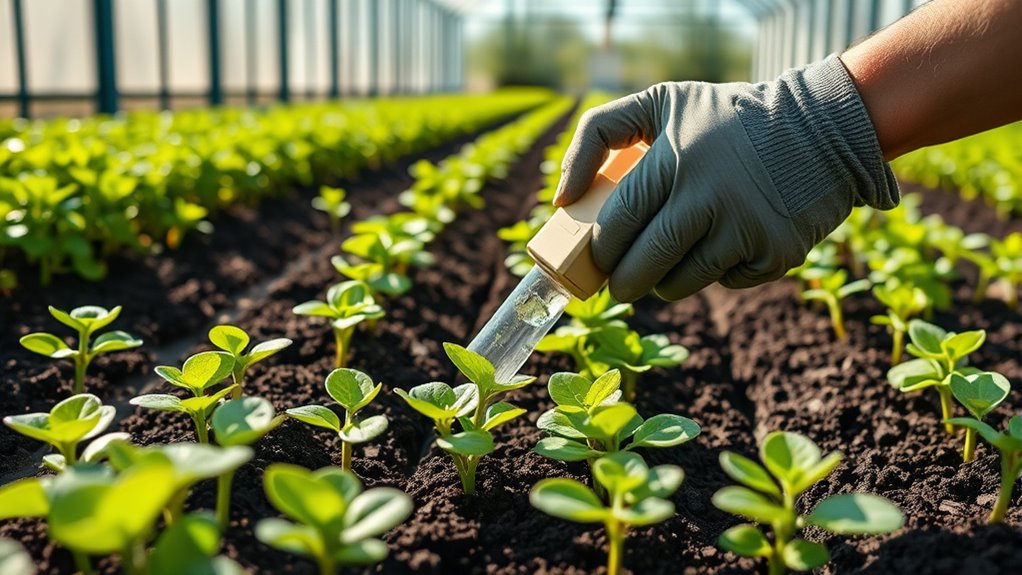
Even with a well-planned fertilization program, challenges can arise that affect plant health and productivity.
Over-fertilization is a key issue, leading to rapid but unstable growth that weakens plants and makes them more vulnerable to diseases. Excess nitrogen can also disrupt the uptake of essential nutrients like potassium and phosphorus, leading to imbalances.
You might notice symptoms such as discolored leaves, slow growth, and root damage.
To prevent these problems, stick to recommended fertilizer dosages and apply them during active growth periods. It's important to monitor your plants closely to catch any signs of over-fertilization early, ensuring you maintain a healthy environment for maximum growth and productivity.
Managing Soil and Substrate Conditions
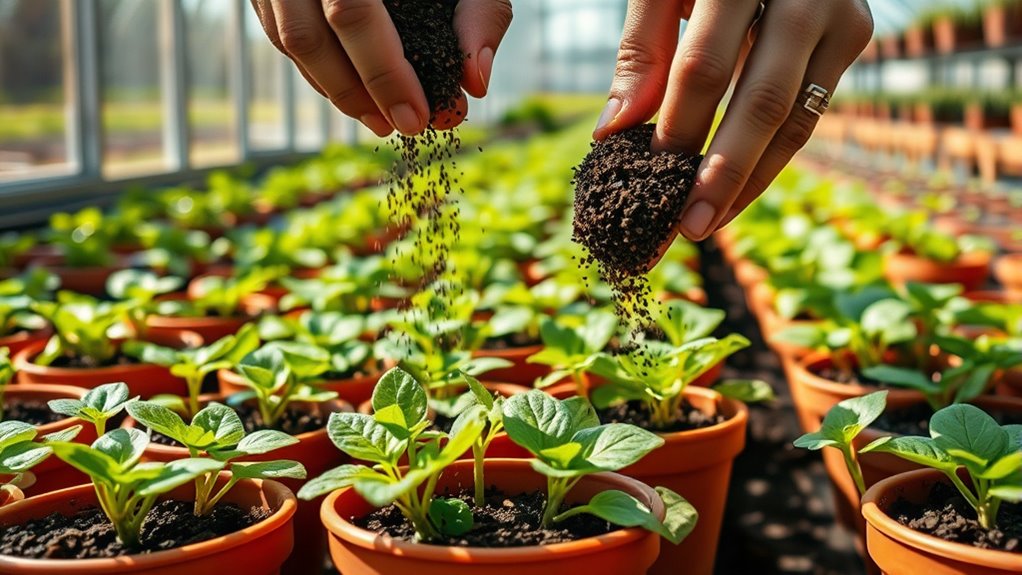
To guarantee your plants thrive in a greenhouse, managing soil and substrate conditions is essential. Start by conducting regular soil tests to assess pH, nutrient levels, and organic matter content. This information helps you fine-tune amendments and identify deficiencies.
Adding organic matter, like compost, improves soil structure and enhances water retention, creating a fertile environment for root development.
Incorporate cover crops during off-seasons to enrich soil and break pest cycles. Mulching is another effective strategy; it retains moisture, suppresses weeds, and regulates temperature.
Don't forget about soil microbiology—introducing mycorrhizal fungi can enhance nutrient uptake. By actively managing these aspects, you'll create ideal conditions for your greenhouse plants to flourish.
Frequently Asked Questions
How Do I Choose the Right Fertilizer for My Specific Plants?
To choose the right fertilizer for your specific plants, start by identifying their unique nutrient needs based on growth stage and type.
Look for balanced nutrient ratios, especially N, P, and K.
Consider the growing medium's pH and nutrient-holding capacity, as well as the water quality you're using.
Finally, think about the fertilizer type—whether you need fast-acting options or slow-release ones—ensuring it aligns with your plants' growth requirements.
What Are the Signs of Over-Fertilization in Greenhouse Plants?
Sometimes, your plants might just be a bit too enthusiastic with their nutrients, showing signs of over-fertilization.
You may notice discolored leaves, drooping or even leaf drop. If roots look blackened or limp, that's a red flag.
Growth could slow down, despite your best efforts.
Keep an eye out for a crusty surface on the soil; that's nature's way of hinting at too much love in the form of fertilizer!
Can I Use Household Waste as Fertilizer in My Greenhouse?
Absolutely, you can use household waste as fertilizer!
By composting fruits, vegetables, and other organic materials, you'll create nutrient-rich compost that benefits your plants.
Just make sure you avoid items like dairy and meat to prevent odors and pests.
Keep an eye on the carbon-to-nitrogen ratio for efficient composting.
This sustainable practice not only enhances your garden's health but also reduces waste and promotes a greener lifestyle.
Enjoy your gardening!
How Often Should I Test My Soil for Nutrient Levels?
You might be wondering how often you should test your soil for nutrient levels, especially if you've noticed some plants struggling.
Generally, it's a good idea to test your soil every two to three years for sandy soils, or every three to four years for clay soils.
However, if you spot symptoms of nutrient deficiencies, don't wait—test right away!
Regular testing guarantees your plants get the nutrients they need to thrive.
What Impact Do Pests Have on Nutrient Uptake in Greenhouse Plants?
Pests greatly impact nutrient uptake in your greenhouse plants. For instance, aphids reduce nitrogen availability, leading to deficiencies that stunt growth.
Whiteflies weaken plants, making them more prone to diseases. Leaf miners damage leaves, hindering photosynthesis and nutrient absorption.
As you manage your plants, keep an eye out for these pests to maintain healthy nutrient levels and overall plant health. Regular monitoring and integrated pest management can help mitigate these issues.
Conclusion
In a greenhouse, getting fertilization right can make all the difference in your plants' growth and health. By understanding nutrient needs and applying the right fertilizers effectively, you're setting yourself up for success. Don't forget to adapt your approach to the unique challenges of your environment—after all, it's essential to roll with the punches. By developing a solid fertilization program, you'll nurture thriving plants and create a flourishing greenhouse that's the envy of all.



